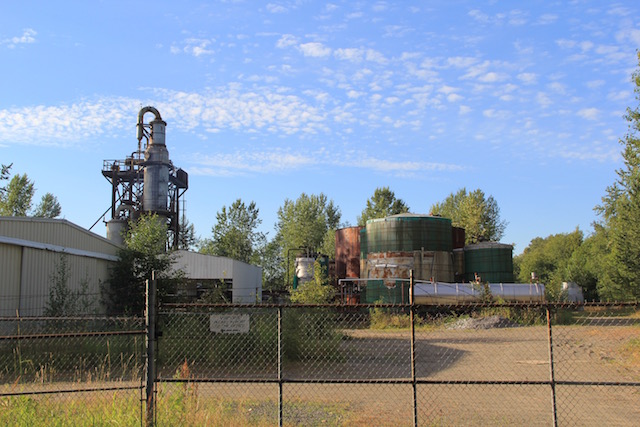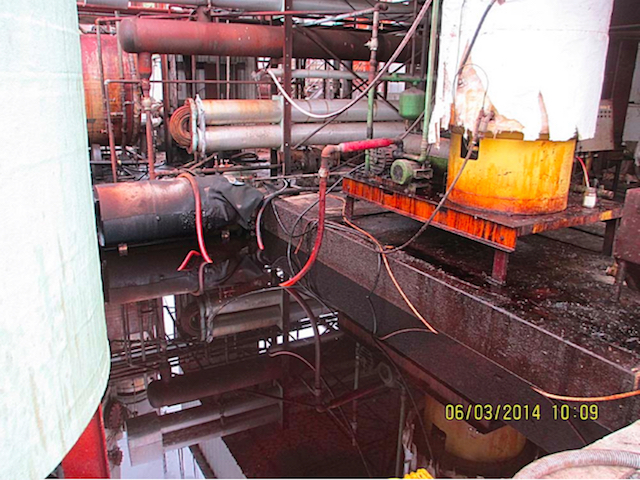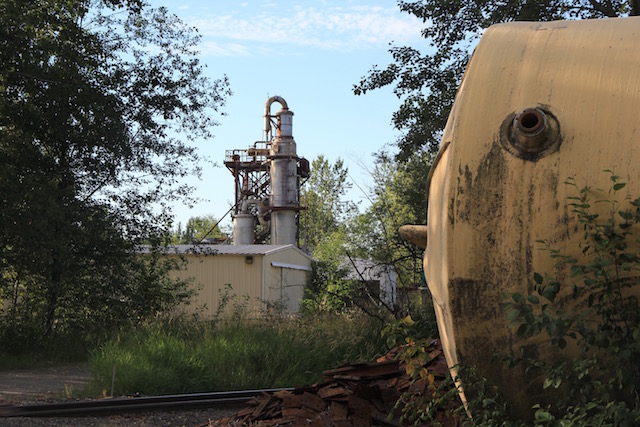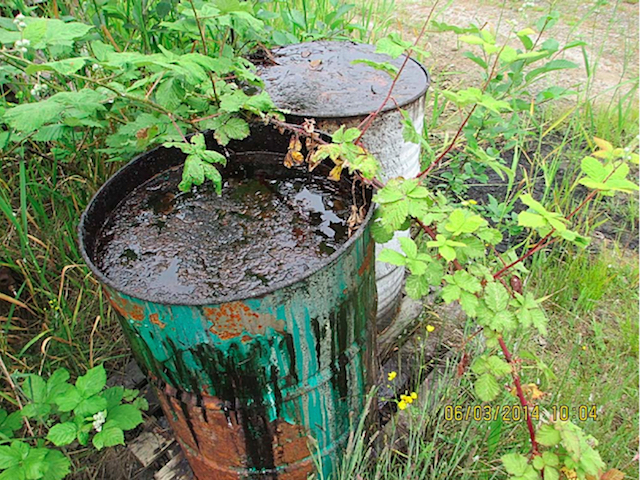After 25 Years, EPA Cleaning Up Toxic Site Near Ferndale

Over the 25 year period that the Treoil facility has been on Ecology’s suspected contaminated site list, it has only been operational twice, once briefly in the 1990s and again between 2006 and 2008. photo: Andrew Wise
by Andrew Wise
On a marshy piece of land sitting in the shadow of the British Petroleum Cherry Point Refinery, just west of Ferndale and south of Blaine, sits a rusting collection of large industrial tanks connected by a spider web of pipes. Until recently, unmarked oil drums loaded with a range of materials, from biofuel material to asbestos and lead, were stacked among the structures, time capsules representing different eras of failed operations and illicit dumping on the site. Some were leaking material into the groundwater, and found its way to the Strait of Georgia.
During its brief operation in the 1990’s, the facility, located at 4242 Aldergrove Road, was Treoil Industries. Located on a 3.5-acre site within a 34-acre parcel of land, the facility refined a material called “tall oil,” a thick, dark, viscous material created as a waste product from paper mills that process pine trees. The tall oil was distilled into products including ink, rubber and emulsifiers for cement.
In March of 2017, an emergency cleanup team from the Environmental Protection Agency (EPA) led by Brooks Stanfield started to clean up the site, a project expected to cost around $1 million. The cleanup marks the end of a 25-year effort by state and county authorities to begin cleaning toxic contamination on the site.
Treoil is a case in point of the considerable challenges state agencies face with the 224 toxic sites awaiting cleanup in Whatcom County, many dating back to the early 1990’s. The challenges are daunting — limited funding to conduct cleanups, limited legal avenues to pursue enforcement, and recalcitrant owners. The property’s fate rests in the hands of an owner who said he avoided cleaning up the site because of his disillusionment with regulators and belief that the site’s commercial potential outweighed the environmental risks. It is likewise a short chapter career of now-County Councilman Satpal Sidhu, who, as a young chemical engineer, served as director of operations during Treoil’s brief operation as a tall oil refinery.
The Treoil case also highlights how difficult it is for state and federal agencies to compel an uncooperative property owner to fund a cleanup, and the unpredictable combination of factors that sometimes pushes the EPA to intervene.
It also offers insights into the evolution of toxics cleanup regulations in the state, from the passage of the Model Toxics Control Act (MTCA) in 1988 to the shifting political landscape around industrial development at Cherry Point.
Toxic Burden
Larry Altose, spokesperson for Ecology, said even if the agency filled all of their staff vacancies in the toxics cleanup program, they would still have a backlog of severe, high priority sites. Toxic cleanup in Washington poses a massive burden. As Treoil shows, that burden gets heavier when a property owner doesn’t see an incentive to fund the work.
“There are a lot of sites that have been cleaned up, but there are also a lot of sites still waiting,” he said. “Our managers have to look at the sites they’re confronted with knowing we don’t have the resources.”

Image from a Department of Ecology field report dated June 3, 2014. This investigation, initiated by a private citizen’s complaint, would eventually lead to EPA intervention. photo: Dept. of Ecololgy
Jagroop S. Gill, a Canadian citizen, incorporated Treoil Industries in the 1980’s with the vision of bringing a new, and profitable, industry to Washington State and built to the design of similar plants located in southeastern United States.
The facility imported waste products from four pulp mills located in Prince George, B.C. and processed into usable material for products ranging from soaps and disinfectants to the rosin bags on major league pitchers’ mounds.
“It was going to be a good industry because it was the only [tall oil refinery] in the Pacific Northwest. We had customers for the product,” said Gill, now 77 years old. He brought in Satpal Sidhu, who had worked for 10 years as an engineer at petroleum refineries in Canada and was also related to Gill by marriage, to operate the facility.
Sidhu said the operation was small-scale because it was designed more as a demonstration project to show the viability of that industry and increase the resale value of the property.
Sidhu said that during construction and its brief operation, everything at Treoil was done according to the rules. As vice president of operations, Sidhu worked with Ecology to procure a National Pollution Discharge Elimination System permit for the facility. NPDES permit requirements were established under the Clean Water Act, but Ecology took over authority on the permits issued in Washington State in 1989.
“NPDES permits weren’t even applicable for small operators at that time,” Sidhu said. “We were learning from each other, and we said, ‘if it’s needed, let’s do it.’”
At the time, Sidhu said, he exchanged toxicological information about the material processed on the site with Ecology in order to figure out how to apply the regulation.
In 1992, an employee at a neighboring facility reported a spill on the site. Sidhu and Gill said they remembered complying with Ecology during and after the inspection, and generally having a good working relationship with Ecology’s inspectors.

The Treoil facility is located on Aldergrove Road, just east of the British Petroleum Refinery at Cherry Point. photo: Andrew Wise
But after operating for only a short period between 1992 and 1994, the market value of the products produced at the facility dropped dramatically. When Gill was unable to negotiate a better price from the mills in Prince George, the machinery at Treoil went quiet.
“We spent a lot of money trying to improve it, then finally said, ‘we can’t do it,’ and shut it down,” Gill said.
He gave Sidhu the option to stay, to wait and see if the market might swing back, but Sidhu moved on. The facility would not refine another drop of tall oil.
In the ensuing years, Gill became frustrated with new regulations related to wetland protection and chemical releases, including increased enforcement for wetland protections on small sites like Treoil.
“We bought it as a heavy impact industrial property for development,” he said. “We didn’t know we had to have a duck farm on it.”
Enforcement Issues
In 1988, as construction began on the Treoil site, Washington voters passed an initiative that would become the Model Toxics Control Act. The act established new rules for the cleanup and control of contaminated sites throughout the state. MTCA established liability for property owners who leave a site contaminated, and make it harder to sell or redevelop a property until it’s cleaned up.
“There are a number of these sites, some are very old,” Altose said. He added that MTCA can be effective in accelerating cleanup in places where there’s money to be made, like the Bellingham waterfront.
“But,” Altose, said in referring to Treoil, “when a site is sitting in a location where nothing is happening, then we get into these situations.”
Department of Ecology documents show a lull in activity on the site until 2000, when inspectors returned to conduct a Site Hazard Assessment under MTCA. The investigation cited bulging, leaking tanks of tall oil-related material as well as heavy oil and diesel contamination, Polycyclic aromatic hydrocarbons, and lead.
The site was ranked a two under MTCA’s hazard ranking scale from one to five, with one being the most hazardous.
Gill disagrees with that hazardous rating. “I don’t understand sometimes the ratings they give these products or the sites. I’m quite confused by that,” he said, later adding, “Anything could be toxic, and this could be toxic it if you don’t use it properly. So could gasoline in your car.”
Any diesel on the ground was only the result of parking vehicles on the site, he said, and any other chemicals on the site were present in small amounts. In an area zoned for industry like Cherry Point, the presence of these materials is inevitable, he said.
He pointed out that the Department of Transportation doesn’t require a hazard label on trucks that transport tall oil. “If you don’t have to put a [Department of Transportation] Placard on it, I don’t see where it becomes hazardous,” Gill said.
The Whatcom County Health Department, however, warns that tall oil can cause skin, eye, and respiratory irritation. And Stanfield of the EPA pointed to concerns about material finding its way into waterways.
“Tall oil has the ability to wreak havoc on an aquatic ecosystem in a similar way to petroleum oil,” he said.
The 2000 Ecology investigation prompted the first assessment by the EPA. A letter dated Sept. 14, 2001, from EPA coordinator Jeff Rodin outlined the potential contaminants on the site and called on Gill to send the EPA documents showing that cleanup was underway.
There is little evidence any cleanup work had started when, in 2006, Gill created a separate entity called TG Energy to develop a biodiesel plant using some of the infrastructure on the site. Gill remained president of the new company and brought in John Caleb to act as Executive Vice President and operate the facility.
A 2006 inspection of the site by Ecology and Whatcom County showed little to no change since 2000. The documents show Caleb and Gill’s intention to start cleaning up the site while simultaneously developing the biodiesel operation. The facility would churn out biodiesel briefly, but the economic downturn in 2008 shuttered the operation, Gill said.

Also from the 2014 Department of Ecology field report. Many containers on the site were not clearly marked and contained unidentified material.
Cleanup Team Steps In
In 2014, a private citizen filed a complaint with Ecology about the status and safety of the site, which eventually lead to EPA taking on the emergency clean up. Whatcom County Health Department officials took photographs showing open oil drums filled with unknown black, shiny substances, rusting tanks leaking material directly into standing water. That report leads with the words, “Condition of the site is awful.”
The report led Ecology to file an enforcement order compelling Gill to remove hazardous materials from the site. Gill appealed that order, but was overruled, putting Ecology in the position of applying penalties if Gill didn’t act. But Ecology didn’t go that route.
“It became clear to us that Mr. Gill was not going to comply with the order, that these materials were going to remain on site,” Altose said, adding that Ecology could have issued a penalty against Treoil. But a penalty would have demanded a lot of the Ecology staff.
“The amount of effort involved and the likelihood of collecting the penalty were question marks we had to consider. We felt the environment would be better protected by working with EPA and getting the removal action going to remove the threat of liquids.”
Gill noted that there are already liens on the property and that some investors had already died without recouping their losses.
The key to getting the EPA involved was invoking violations of the Clean Water Act of 1974 when waters of the United States are at risk. In this case, there was evidence that tanks and drums on the site were leaking and that most of the site is a wetland heavily saturated with shallow groundwater. A map produced by the EPA team shows that water flows from the site into a ditch along the western edge of the property, then into another ditch along Aldergrove Road. It then flows into a small, unnamed stream west of Gulf Road that winds its way south into the Strait of Georgia.
In March, after a steady stream of reports and conversation back and forth between Mindy Collins, a Hazardous Waste Compliance Inspector at Ecology, and Stanfield at EPA, the emergency cleanup team moved in, cataloging and removing material from the site. An especially rainy winter sparked concerns about runoff from the site flowing into the Strait. The team removed more than 7,000 gallons of glycerin crude, a byproduct from the biodiesel operation, from the site. They also removed dozens of drums and other smaller containers that held 345 unidentified chemicals.
Stanfield said he was surprised to find drums with a layer of sand covering asbestos-containing material, and drums filled with material that was 20 to 40 percent lead.
“We always anticipated there’d be stuff we didn’t anticipate. That’s just kind of the nature of the beast with these sites,” he said.
The team left some aboveground storage tanks that are sitting on soil so heavily saturated with water that heavy equipment ran the risk of getting stuck. They were to return in late July to complete the cleanup on dry soil with the goal, Stanfield said, of finishing by Aug. 4.
Work Remains
For Ecology, federal intervention was a victory.
“This EPA removal action is something we greatly appreciate because it gets a lot of the immediate threat removed,” Altose said. “This is something that’s the responsibility of the owner, the owner wasn’t carrying out the responsibility, and it needed to get done.”
But once the EPA team leaves, plenty of work remains. The emergency cleanup team focused on the immediate threats to nearby bodies of water, but there will be large amounts of solidified tall oil and other old infrastructure yet to be dealt with.
Sidhu, now in his third year as a Whatcom County Councilmember, wants to see better enforcement for cleanup action on all such sites.
“I have no idea why it would take 25 years to get to this point,” Sidhu said. “I think we should have much stronger enforcement laws, and I think we should have enforcement when things happen, right then.”
_________________________
Andrew Wise is completing degrees in environmental policy and journalism at Western Washington University. A native of Colorado, reporting on northwest Washington is starting to make Whatcom County feel like home.
